#Jewish tradition
Explore tagged Tumblr posts
Text
Two Plates, Three Jews
One night, my friend Josh was insisting that keeping kosher cutlery and dishware is actually a very easy task. Our other friend Hao and I were nodding along until he exclaimed “This is why you only have two plates!”
“Two plates?” I clarified, distracted from the task of subtly trying to pick out a hair from my hand. Hao sat up from where I’d stacked pillows from him, sending them all to the ground. “Like you only have two plates?”
“Uh, yeah,” Josh shook his head like I was stupid. (And to be honest I am but for reasons separate from this conversation. ) “Two plates. Two forks. Two knives. That’s all you need for your life.”
Hao and I stared at each other. We shared a look encompassing what I can only describe as complete horror, comprehension, and the tiny feeling of being a bit impressed.
Josh pointed to the two cupboards in his tiny student kitchen, side by side. “That’s my dairy one,” He pointed to the left. “That’s my meat one,”
“Ha, ha.” Hao said, still a bit horrified. “Your meat”
We approached the cabinets tentatively. I can’t describe to you how hilarious it is to open them side by side and just in each of them, see a singular plate, fork and knife sitting forlorn like lonely soldiers.
“I really, really” Josh insisted as we turned to stare at him in wonder. “Don’t see what the big deal is.”
#fromgoy2joy thoughts#jumblr#jewish#jewblr#jewish convert#jewish tumblr#jewish conversion#jewish humor#kosher food#kosher#jewish joy#jewish tradition#jewish stuff#judaism stuff#judaism#jewishness
919 notes
·
View notes
Text
there is a very cruel irony that, at the same time as people progress a blood libel against jews—that our self-determination is just an excuse to murder children—people are appropriating the figure in jewish tradition that represents infant mortality—a demon that exists to murder children—as a figure of female empowerment & individualistic self-determination
#and sometimes it’s the very same people doing both#lilith#jewish#jewish folklore#jewish mythology#jewish tradition#jumblr#antisemitism#AZAS#cultural appropiation#blood libel
321 notes
·
View notes
Text
In this zine we present you the jewish symbols of the famous SchUM cities - Speyer, Worms and Mainz. They were important jewish communities from the High Middle Ages, and SchUM is the acronym made up of the first letters of the hebrew names of the cities.
The symbols were taken from tombstones, synagogue ornamentations, floor tiles and even from a mikveh. We used linocut prints for creating the zine, where along with the symbols you can read about its meaning and a bit of history about their place of origin and the communities.
The importance of the SchUM cities that they were significant centers of ashkenazi judaism, showcasing early, well-preserved jewish community life, architectural innovation and scholarship. These communities considered as a cradle for ashkenazic judaism, many customs and regulations existing still today actually came from the communities that lived here.
#jewish#jumblr#art#judaism#cemetery#illustration#hebrew#zine#print#germany#schum#speyer#worms#mainz#tradition#jewish tradition#jewish religion#symbolism#symbol#motifs#ornament#middle age#medieval
253 notes
·
View notes
Text
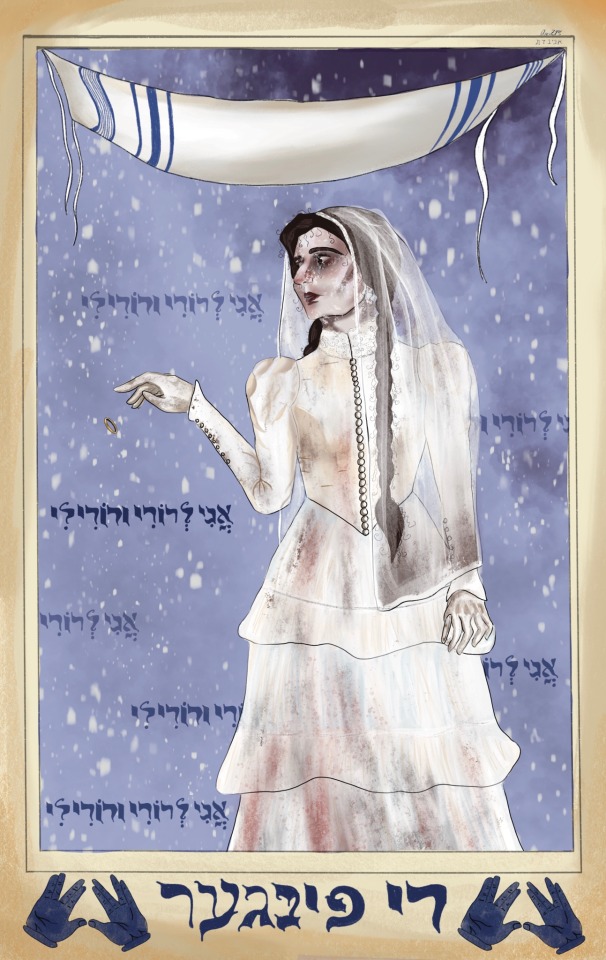
As Halloween approaches, I’ve been seeing many very talented makeup artists recreate the face of the bride in Tim Burton’s “The Corpse Bride.” I thought this would be a good oppertunity to make some art and remind one and all that the “The Corpe Bride” (known in some tellings as “The Finger” or “The Demon in the Tree”) is a beloved Jewish folktale. Folklorist Howard Schwartz traces the orgins of “The Finger” to 16th century Levant. Aftrer hundreds of years of retelling, the story, like all folktales, has undergone many iterations and also became highly informed by the violence of life in the Pale of Settlement (specifically towards women and young brides).
If you'd like to support me, you can do so here <3
#digital art#art#original art#jewish#jewish art#jewish culture#jewish tradition#jewish things#jewish folklore#jewish folktales#jewish folktale#jewish history#jumblr#folkart#folk art#jewish folk art#jewish folkart#halloween#the corpse bride#der finger#the finger#the demon in the tree#tim burton#tim burton corpse bride#corpse bride#jewish artist
2K notes
·
View notes
Text





I wasn’t going to post anything else today with all that has happened in Israel but evil will not win.
While my heart and prayers are with all the victims and my people, here is a simple lesson on Jewish traditions during Rosh Hashanah.
Traditional Rosh Hashanah foods are symbolic, reflecting hope, renewal, and blessings for the new year. Key examples:
Apples in honey – Wishing for a sweet new year.
Round challah – Symbolizes life’s cycle and continuity, often sweetened with raisins.
Pomegranates – Represent abundance and the 613 commandments
Fish head – Symbolizes the hope to lead and make progress.
These foods are part of the Rosh Hashanah seder, accompanied by prayers and blessings for a fruitful and positive year.
366 notes
·
View notes
Text
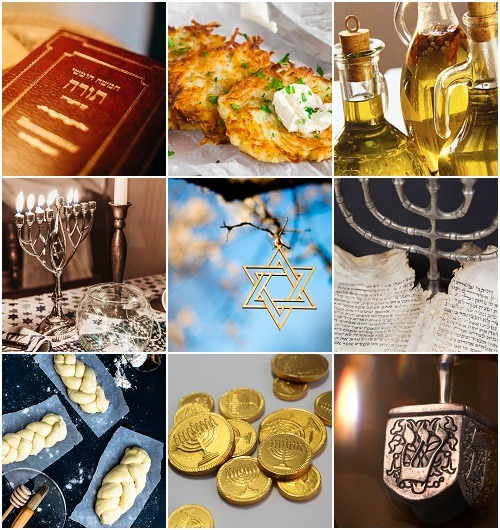
Holidays: Chanukah (Hanukkah)
The darkness of the whole world cannot swallow the glowing of a candle.
#chanukah#hanukkah#jewish holidays#jewish history#december holiday#jewish#judaism#Eight nights of Chanukah#festival of lights#Robert Altinger#kislev#menorah#sufganiyot#latkes#dreidels#holidays#holiday aesthetic#Holiday moodboard#jewish culture#jewish heritage#jewish tradition#jewish spirituality#cultures#Culture aesthetic#100 notes#300 notes
375 notes
·
View notes
Note
I started reading When the Angels Left the Old Country after I saw it recommend on your blog and I’m OBSESSED and I just think EVERYONE needs to know about it. The flavor, the Jewish, Yiddish, alter velt flavor of this book- impeccable.
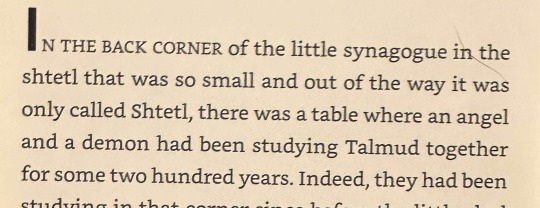
Literally excuse me??? Screaming??? At this opening??? When do we ever get books like this?? Well written, plotted, just chef’s kiss??? Talk about a book that makes you proud to be a part of its heritage (disclaimer I have only read through chapter 4 lol).
i know. ohhhh i know. it's that feeling of recognition. the feeling of the familiar cadence of Yiddish that comes through, even in the English. it's the folk traditions, barely remembered from childhood. it's the way that this little angel and demon are Jewish. the little angel is genderless, and refers to itself as "it". the little demon is one of the sheydim. and yet the little demon is terrorized by the goyishe demons in the towns nearby. it's the way that they have always been here. the way that Shtetl grew up around them. it's the way that they care about the little villagers.
it's that feeling of someone taking us by the hand and saying, "yes. i know. i see you. these are our stories".
#i've been pausing every few pages because i start tearing up...#when the angels left the old country#sacha lamb#judaism#jumblr#jewish history#jewish literature#jewish tradition
174 notes
·
View notes
Text
Tradition
A Rabbi was embarking on a study of local traditions for Jewish groups. Their focus was in exploring smaller synagogues and finding out if they participated in any older or newer customs and trying to find out where they originated from.
Such as finding a remote synagogue that perhaps said certain prayers on Shabbat in a different order than the usual order.
While visiting a small synagogue in the south, they attended a Shabbat and were intrigued to watch as when they brought out the Torah and went on their rounds through the group. When the carrier or the Torah turned down the center aisle, they would dip down very low, almost as if bowing, for a couple of steps, then would rise and carry on.
They returned the next week and witnessed the same thing. What tradition was this? Some forgotten motion of bowing from one of the old countries? Perhaps something long lost from the days of the Temple?
They spoke with the carriers and they didn't know where it had come from either, but it was something they had seen their predecessors do so they did it too.
The Rabbi did some research into the synagogue themselves and finally spoke with a few members who had been there for a long time.
It turns out, ten years prior, the synagogue had been under construction and one of the beams above had broken and hung down across the path, causing the Torah carriers to have to duck down to prevent them from hitting their heads.
When the beams had been repaired, the carriers were so used to ducking that they continued to do so. The next ones to carry the Torah had seen this and they too started to duck down in the same spot.
Now, years later, head bumping hazard now gone, it was a tradition to always duck in the same spot.
The Rabbi that told us this story today smiled keenly after she finished shaking the Lulav and Etrog in the standard directions then gave a little spin in a circle while shaking them all about. "I hope that ten years from now, someone will pass on my tradition and wonder what grand meaning and ancient custom it comes from. In truth, it's just a personal reminder that this holiday is about joy and that sometimes we just have to be a little silly."
#Jumblr#judaism#jewish stuff#just jewish things#jewish tradition#Reminder to be silly sometimes#it's good for the soul
35 notes
·
View notes
Text

42 notes
·
View notes
Text


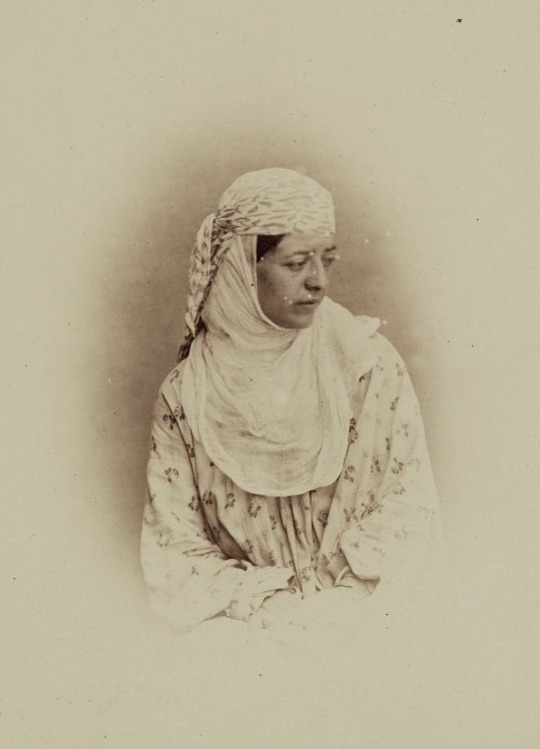

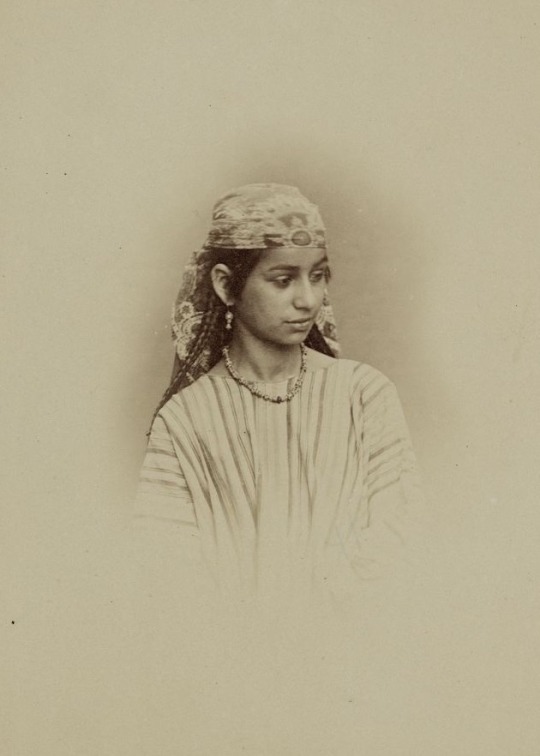




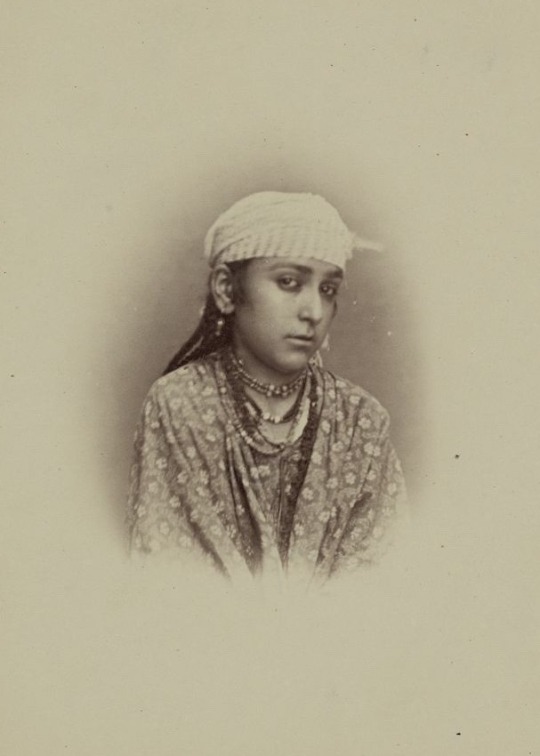
Jewish women of Turkestan Krai, Central Asia.
Anonymous photographer, c. 1865-1872.
#jewish#1860s#1870s#old photos#women#mine#jewish history#early photography#19th century#antique#jewish tradition#old photography#jewish women#historic photographs#antique photo#women in history#nineteenth century#vintage style#jewish tumblr#jews of tumblr#vintage#historical photos#jewblr#women in photography#vintage photography#old photo#photography#vintage women
108 notes
·
View notes
Text
Hey Jews of Tumblr!
What's your favorite Jewish practice? This can be anything, whether it be a mitzvah that you find really important, a holiday practice, a Jewish value, etc.
Personally I like the fact that we are encouraged to question everything. I don't like taking things at face value and need to understand them, which is why I appreciate not only the acceptance, but also the encouragement of questioning things.
Goyim, do not respond. Those in the conversion process are welcome!
319 notes
·
View notes
Text
People in the process of conversion to Judaism have a rough time with labels.
You’re not a goy. Maybe, you could say, in the strictest definition you are- as in not initiated in bet the Beit Din or immersed in the mikveh. But not in the social sense of being on the outside of the community, seperated from all Jewish practices until the official moment of “you’re a Jew now!” No one’s going to knock challah away from your hands because you’re cosplaying.
No. You show up to shabbats. You’re at the minyans. You’re in the community and say the brachats. You keep kosher. And maybe you’re discriminated against for being apart of this world.
You’re basically a resident, working on all the citizenship paperwork. There’s a lot to do and you feel constantly behind. But sooner or later, you find yourself living a completely Jewish life. Without the official check mark.
And when people in the community try to explain your presence, they wave their hands and nearly glitch. “Uhhhhh she’s Jewish- not Jewish, no! But working on it!”
I wouldn’t take this away for the world. It’s a long good road at the start of a lifelong journey.
But for my Jews to be? I see you in our awkward phase. Let’s take our time- we’re getting there.
#fromgoy2joy thoughts#jewish convert#jewish tumblr#jewblr#jewish#jumblr#jewish conversion#tw antisemtism#jewishness#jewish conversion journey#jewish tradition#Jews to be
592 notes
·
View notes
Text
Hi, all! I know I have some asks to reply to and I will, but this weekend is Rosh Ha'Shana, the Jewish New Year, and I will be with my family. I hope you can be patient with me until I can reply to you.
To all Jews who see this: may a year and its curses end, may a year and its blessings begin.
As we watch antisemitism rise, as hatred in general intensifies, I am going to choose to intensify my love. I will love you, my fellow Jews, more than ever, and I will love you, my fellow humans, more than ever. May we all find the blessing that exists in each day.
Adding a Yemenite Jewish traditional song for Rosh Ha'Shana performed in a modern (and lovely IMO) arrangement. Shana tova u'metuka!
youtube
#personal#judaism#jewish#jew#jews#jumblr#frumblr#rosh hashanah#antisemitism#jewish music#music#jew stuff#jewish stuff#jewish culture#jewish things#jewish thought#jewish tradition#love is the answer#Youtube
121 notes
·
View notes
Text



Matzah holder with seder plate from the collection of the Hungarian Ethnographic Museum
This stand, carved from tropical wood and covered with embroidered textile sheets, was collected by Gyula Grünbaum in Sopronkeresztúron (now Deutschkreutz, Austria) in 1913. From the 17th century onwards, important Jewish communities were established in the seven field towns of the Esterházy estate. The famous Talmudic school of Sopronkeresztúr, known in Hebrew as Zelem, attracted young people from far and wide. Most of the Jewish objects in the Ethnographic Museum come from this village. In the early 1910s, Grünbaum collected ritual objects in Sopronkeresztúr that were rarely or never used by the Jewish community. Both the changing customs in the traditionalist settlement and the worn condition of the objects could have justified their sale.
Four carved columns hold the three shelves for the maces and the fourth, upper shelf, the 'seder tray', which holds six bowls on legs for ritual food. On the textile covering are embroidered Torah quotations in Hebrew for the Passover feast: "And the people carried their dough before it was boiled, tying their pots into their clothes on their shoulders." (Exodus 12:34) "And they baked the dough, (...) a leavened cakes" (Exodus 12:39) "And they ate the flesh that night, roasting it on the fire, with unleavened bread and bitter herbs." (Exodus 12:8).
33 notes
·
View notes
Text
Ethan Freeman performs Stephen Sondheim's "No One Is Alone" at "Together at Hanukkah" an event of love and light for the Jewish community and raise money for the MDA the Magen David Adom the Israeli paramedic organization.
You can watch the full show featuring stars including Tovah Feldshuh and Avi Hoffman on Behindthemirrorofmusic.com here you can also find ways to donate.
---
Ethan Freeman has been a beloved star of the stage for over fourty years. His credits include being the first Jewish actor in history to perform the role of The Phantom in The Phantom of the Opera (performing the role on West End and also in Toronto, Vienna and Germany,) and being chosen by Disney to originate the role of "The Beast" for Disney’s Beauty and the Beast European premiere.
Other credits include: Javert in Les Miserables (West End,) and creating the dual role of Jekyll and Hyde for the original German premiere.
In recent years he has also become known for another artform: painting. Since October he has used this medium to fundraise for the MDA, donating the money for every painting sold to the charity.
#ethan freeman#poto#phantom of the opera#european musicals#stephanie brown#into the woods#jewish heritage#jewish tradition#jewish holidays#jumblr#jewish history#jewish
50 notes
·
View notes
Text



In Hebrew, we often wish for a good year – Shanah Tovah, but this year, the words feel a bit different. After all we've been through, and what still lies ahead, it feels fitting to add a little hope for something more – for a better year.
In Hebrew, שתהיה זו שנה טובה יותר "May this be a better year."
As we stand on the cusp of this new Jewish year, my wish for you and your loved ones is a year that brings more light, peace, and healing. A year filled with love, growth, safety, and joy. May it be a time of renewal and strength, and may we all find the beauty, wisdom, and blessings that lie ahead.
Let’s walk forward with open hearts and a hope for better days 🍯🍎
#shanah tovah#hebrew#rosh hashanah#hope#jewish tradition#jewish new year#jumblr#hebrew langblr#langblr#jewish#language#israel#happy new year
112 notes
·
View notes